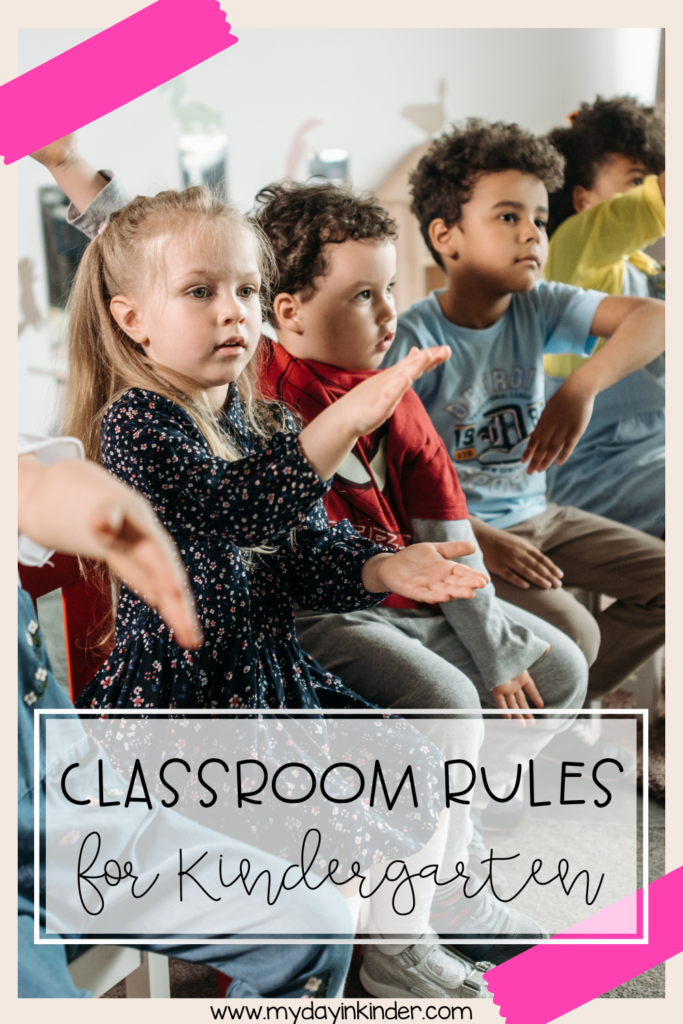Classy Classroom Rules for Kindergarten
Hey there, fellow Kindergarten teachers! If you’re anything like me, you know that setting up a well-managed classroom can be exciting and a bit overwhelming. The first week of school is always full of new faces, eager young learners, and—let’s be honest—plenty of behavior surprises. But don’t you worry! If you’ve been following along with me, you know this is where I shine, and if you haven’t been following My Day In K for long. Get ready because we’re about to chat about the very, very, VERY important role classroom rules for kindergarten play in class. Plus, how to set up a positive, well-managed Kindergarten classroom that makes the beginning of the year smooth and fun.

Setting Clear Expectations
Alright, let’s start with the basics. One of the most important things to remember when creating classroom rules is that clear expectations are key. Young students thrive on routine and clarity, so having a straightforward list of classroom rules is essential. Think simple and positive: “Walking Feet” instead of “Don’t Run” or “Use Kind Words” rather than “No Shouting.” Clear rules help Kindergarten students understand what’s expected of them in a way that’s easy to remember and follow.
To kick things off, you might want to involve your young learners in the rule-creation process. This can be a great way to get them excited about following the rules and give them a sense of ownership over their classroom environment. Create an anchor chart together that lists the kindergarten classroom rules in a way that’s visual and easy for the kids to understand. This is not only a powerful tool for reinforcing expectations but also a fantastic way to build a strong classroom community from day one. Click HERE to grab this FREE Classroom Activity.
Positive Reinforcement and Rewards
Now, let’s talk about positive reinforcement. One of the best ways to encourage good behavior is through a reward system. It’s amazing how a little positive reinforcement can go a long way in shaping student behavior. You might consider using a behavior chart where students earn stickers or small rewards for demonstrating good behavior. Make sure to celebrate those smart choices and good behavior often!
But remember, the reward system doesn’t have to be elaborate. Sometimes, a simple positive reinforcement like “Wow, I love how you’re using walking feet!” can be just as effective. Positive phrases and visual reminders help reinforce classroom expectations and encourage students to continue making good choices. This approach not only promotes a positive learning environment but also helps young students understand the link between their actions and rewards.
Consistent Routines and Logical Consequences
Consistency is key to managing a Kindergarten classroom. Having a predictable routine helps young children feel secure and understand what to expect throughout the day. Establishing a clear classroom routine from the beginning of the year is one of the best ways to support effective classroom management. Whether it’s morning circle time, independent work periods, or transitions between activities, consistency helps students know what’s coming next and reduces anxiety. Click HERE for my FREE schedule cards.
Of course, not every day will go according to plan, and that’s where logical consequences come in. It’s important to address inappropriate behavior in a fair and consistent way. For example, if a student isn’t using their walking feet, a logical consequence might be to practice walking in a designated area. The goal is to help students understand the impact of their behavior and encourage them to make better choices in the future.
Practical Tips for Kindergarten Classroom Rules
So, what are some of the best ways to implement these strategies? Here’s a closer look at some practical tips:
- Keep It Simple: Use a few broad, positive rules that are easy for young children to understand and follow. For example, “Respect Others” or “Take Care of Things.”
- Use Visual Aids: Incorporate visual cues like pictures or charts to reinforce rules and routines. Visual reminders can be incredibly effective in guiding young students, and having visual directions for tasks is also helpful in keeping students on task.
- Be Consistent: Consistency is crucial in maintaining a positive classroom environment. Make sure to consistently reinforce rules and follow through with logical consequences.
- Build Strong Relationships: Creating personal connections with your students can make a big difference in their behavior. When children feel valued and understood, they are more likely to follow classroom rules and engage positively. Click HERE for community building digital slides.
- Celebrate Success: Remember to celebrate when students follow the rules and make good choices. Positive reinforcement, whether verbal praise or a small reward, helps reinforce the behavior you want to see.
Implementing effective classroom rules for Kindergarten is all about setting clear expectations, using positive reinforcement, and maintaining consistent routines. You’ll create a positive learning environment where young children can thrive by keeping rules simple and positive, celebrating good behavior, and fostering a strong classroom community. Remember, the beginning of the school year is a great time to lay the groundwork for a successful and enjoyable year ahead. So, embrace these strategies, and watch as your classroom transforms into a place where respect, kindness, and positive behavior become second nature.




